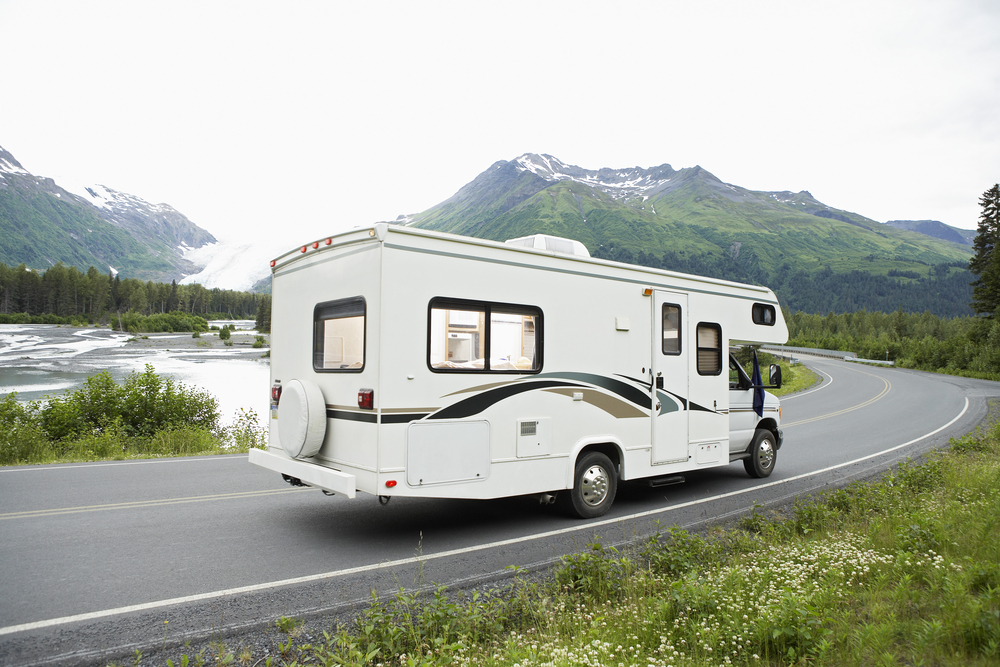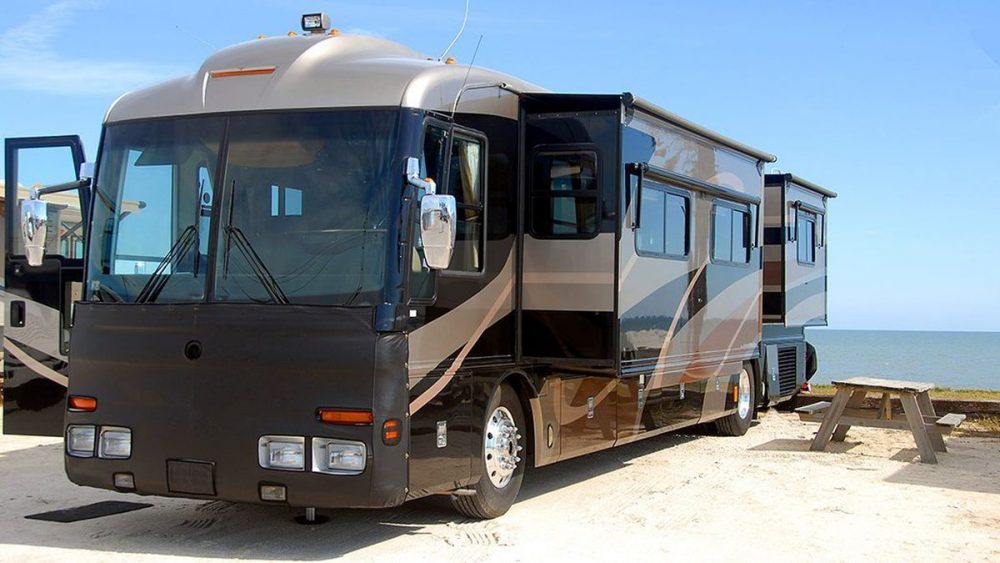RVs are an exciting way to travel the world, making it easy to simply get up and go whenever the mood strikes. But if you’re just diving into the world of motorhomes and trailers, you probably have a few questions. Mainly, how wide are RVs?
RVs vary in width from 6 feet to 9 feet depending on what size you choose. Travel trailers run on the smaller side, while motorhomes take up far more space.

Contents
- 1 What Is the Standard Width of an RV?
- 2 What Is the Maximum Width of an RV?
- 3 How Wide Are RVs With Slide-Outs?
- 4 Average RV Width According to Class
- 5 Do Different States Have Different RV Width Requirements?
- 6 How Do You Measure the Width of Your RV?
- 7 Why Should You Know Your RV Width?
- 8 What is the Best RV Size?
What Is the Standard Width of an RV?
The standard width of an RV will vary depending on the RV’s class. Most range from 96-101 inches, with the average width of your typical RV being 100 inches. However, once parked, that width can get wider through the use of slide-out features.
What Is the Maximum Width of an RV?
State and federal law have restrictions on how wide an RV can be, which is 8-9 feet, depending on the state. However, RV manufacturers support a 102-inch, or 8.5-foot, maximum, for their vehicles.
How Wide Are RVs With Slide-Outs?
RV slide-outs include any feature on your motor home that you can pop out when you need it and slide back in when you don’t. These features extend the square footage of your motorhome, giving you more space to move around.
You’ll often see slide-outs used to add to the bedroom, eating, or living areas. The average width of a slide-out is 2-3 feet. Although that may not seem like much, it’ll actually make your space much more maneuverable.
Average RV Width According to Class
RVs can be sorted into two different categories: motorhomes and trailers. Motorhomes are driveable; quite literally, a home with a motor. Towable RVs are trailers that require a second vehicle to get around.
The three RV classes are A, B, and C. In addition, there are two types of towable RVs, which are travel trailers and 5th wheel motorhomes.
How Wide Are Class A RVs?
The largest RV you can purchase is a Class A motorhome, which will span about 9 feet, including mirrors. A Class A more closely resembles a bus and can be up to 45 feet long. These are the kind of RV you want if you’re going to be living on the road.
How Wide Are Class B RVs?
Class B RVs, otherwise known as sleeper or camper vans, are the smallest type of motorhome you can get. They’re typically about 7 feet wide, making it easy to get around. These are the most versatile RVs because they don’t require quite as much skill to drive and park, and they don’t take up nearly as much space.
How Wide Are Class C RVs?
Class C RVs fall right in the middle, with a width of about 8 feet. They’re not quite as bus-like as Class As, but they offer a more spacious interior than Class Bs. Since they’re built on a regular pickup truck chassis, they’re often much more comfortable to drive than larger RVs.
How Wide Are Travel Trailers?
Travel trailers can vary in width depending on what your uses are, but the typical range is 6-8 feet wide. Compact travel trailers usually max out at about 7 feet. However, no matter how wide a travel trailer you choose, many have slide-outs that’ll add square footage.
How Wide Are 5th Wheel Motorhomes?
5th wheel RVs are the happy medium between a full motorhome and a standard travel trailer. At about 8-8.5 feet wide, they give you the same space as a Class C, but you don’t need to be especially skilled to drive one, since you’ll use your own vehicle to tow it.
Do Different States Have Different RV Width Requirements?
Federal law requires RVs not to exceed 8.5 feet in width. However, specific states have their own regulations, so you should take care to be aware of the rules when traveling.
8′ Maximum States
Many states have an 8-foot maximum width requirement for all RVs and motorhomes. Bear in mind that this restriction only applies to smaller roads and urban areas. You won’t have an issue on the open highways or interstates.
If you have a wide Class A motorhome, take care when you visit these states:
- Alabama
- Arizona
- Delaware
- Illinois
- Maryland
- Missouri
- New York
- Tennessee
- Washington, D.C.
- West Virginia
One caveat to this rule is in Delaware, where you can get away with an 8.5-foot-wide trailer.
9′ Maximum States
Currently, only Hawaii and Massachusetts have 9-foot maximum width requirements for motorhomes. However, Massachusetts has an 8.5-foot limit on fifth-wheel trailer motorhomes.
Each state not included on either of these lists maintains the Federal 8.5-foot maximum width requirement with the exception of Connecticut, which limits RVs to 7.5 feet on certain roadways.
How Do You Measure the Width of Your RV?
Measuring your RV’s width is pretty simple, but you have to make sure you’re measuring from the right places to get the most accurate measurement. Although your owner’s manual might offer measurements, it’s not a bad idea to double-check, just in case.
First, find your RV’s widest point. This will likely be where a ladder or mirrors jut out, but you might have another type of protrusion that adds to your RV’s girth. Then, measure the width with and without the mirrors, as well as the length and height, so you have all of your measurements at hand.

Why Should You Know Your RV Width?
There are several reasons why it’s a good idea to know all of your RV’s measurements, including its width. Essentially, the width determines where your RV can fit. Knowing your width will give you the best insight into whether you’ll be able to fit in a certain area.
RV Parking Space
When you purchase an RV, you’ll need a place to park it, both at home and when you travel. Although some locations have RV-specific parking spots, you’ll still need to be confident your vehicle will fit. This is especially true if you have a larger motorhome that pushes the size limits.
Safety
Safety is the main reason you should know your RV’s width, as well as its other measurements. RVs are much taller than your average daily vehicle, so you’ll need to start noticing the signs that warn you about clearance height when you’re driving.
For example, the average Class A is 13.5 feet, which fits perfectly under newer bridges and overpasses. However, you could find yourself stuck high and dry if you come across an older bridge that barely reaches 10 feet.
Local Regulations
Different states have different rules. Although you’re legally allowed to drive your 9-foot RV on certain federally-funded roads and highways, you might run into some trouble if you try to drive through a city with an RV that’s too wide. Knowing the width of your RV will make it easy to ensure you’re adhering to local regulations.
Storage
If you’re building RV storage or need to store your RV off-site at a storage facility, you’ll need to know how much space you need. Taking the measurements will let you know what size RV port to build or what size storage space to rent.
Camping
When you take your RV camping, you’ll need a hookup site that’s adequate for the size of your vehicle. When you know in advance how much space you’ll have to move around at your campsite, you’ll be able to plan better and have a more enjoyable vacation.
What is the Best RV Size?
The best RV size is whichever you feel most comfortable with combined with which one meets your needs. For example, if you’re planning to live on the road and want maximum luxury, a Class A is the way to go. On the other hand, if you’re pinching pennies for a cross-country trip, a travel trailer might be a better choice. Either way, there are plenty of options out there, no matter your plans.




